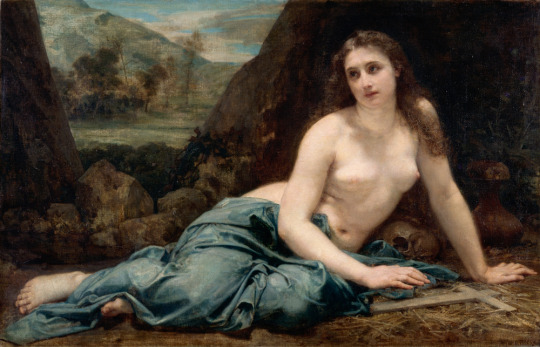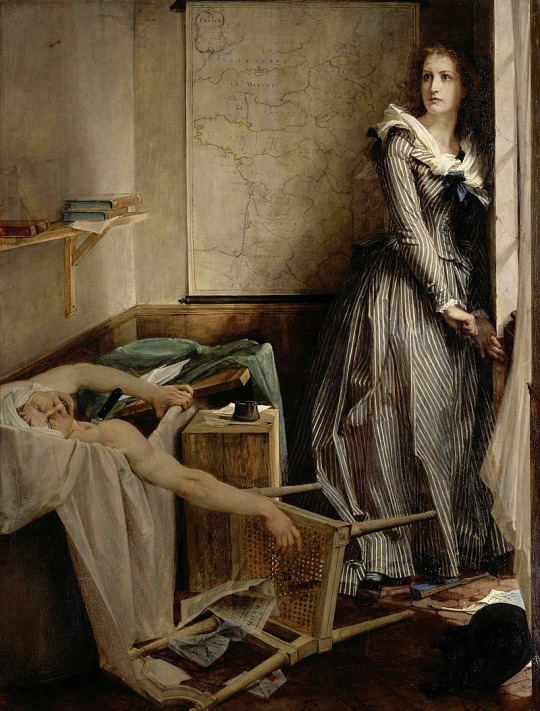#paul-jacques-aime baudry
Explore tagged Tumblr posts
Text

Penitent Magdalene by Paul-Jacques-Aimé Baudry (1858)
#paul baudry#art#paintings#fine art#19th century#19th century art#academicism#academism#academic art#painting#french art#french artist#religion#religious art#mary magdalene#paul-jacques-aime baudry#classic art
1K notes
·
View notes
Text

Paul-Jacques-Aimé Baudry
#paul jacques aime baudry#art#artwork#fine art#fineart#painting#art history#history of art#women in art
44 notes
·
View notes
Text

Crouching Nude Male Figure - Paul-Jacques-Aime Baudry - 19th century
13 notes
·
View notes
Text

Paul-Jacques-Aimé Baudry (1828-1886) "Charlotte Corday after the Assassination of Marat" (1861) Oil on canvas Located in the Musée d'Arts de Nantes, Nantes, France Charlotte Corday (1768-1793) was a figure of the French Revolution; she was in 1793 executed by guillotine for the assassination of Jacobin leader Jean-Paul Marat, who played a part in the more radical course the Revolution took through his role as a politician and journalist. In 1847, writer Alphonse de Lamartine gave Corday the posthumous nickname l'ange de l'assassinat (the Angel of Assassination).
#paintings#art#artwork#history painting#french revolution#paul jacques aimé baudry#paul jacques aime baudry#oil on canvas#fine art#musée d'arts de nantes#musee#museum#art gallery#french artist#history#murder#political assassinations#politics#clothing#clothes#dress#dresses#1860s#mid 1800s#mid 19th century#direct action
179 notes
·
View notes
Photo

Art by Paul Jacques Aimé Baudry (1828 – 1886)
10 notes
·
View notes
Photo

The Wrestler Meissonier
1 note
·
View note
Photo

Truth - Paul-Jacques-Aime Baudry
28 notes
·
View notes
Photo

The Death of Vitellius. 1847. Paul Jacques Aime Baudry French 1828-1886. oil/canvas. http://hadrian6.tumblr.com
101 notes
·
View notes
Photo

“The Wrestler Meissonier”, c.1848 by Paul Jacques-Aime Baudry (1828-1886). French painter. oil on canvas
157 notes
·
View notes
Photo

BAUDRY, PAUL JACQUES AIME (1828-1886), French painter,
128 notes
·
View notes
Text

La Perle et la Vague by Paul-Jacques-Aimé Baudry (1862)
#paul-jacques-aime baudry#art#paintings#fine art#19th century#19th century art#academism#academicism#academic art#painting#french art#french artist#wave#pearl#paul baudry#classic art
931 notes
·
View notes
Text

Happy Birthday, Paul-Jacques Aime Baudry (1828-1886)
Charlotte Corday, 1860
1 note
·
View note
Photo

Stunning work!!! #ArtAppreciation ♥️🖼🎨 "The Pearl and the Wave" (1862), Oil on canvas at Museo del Prado. Artist: Paul-Jacques-Aimé Baudry (French, 1828 – 1886) https://en.wikipedia.org/wiki/Paul-Jacques-Aim%C3%A9_Baudry "An intensely sensual female nude that presents the figure in the form of a pearl enclosed in its box, the ocean, which may be an allusion to the birth of Venus. Presented at the Paris Salon of 1863, this work was one of the most appreciated female nudes of Second Empire Paris, despite the strong criticism it received as an exultantly erotic work lacking any moral modesty. Its first owner was the Empress Eugenia de Montijo, and her work entered the Prado Museum as part of the legacy of Ramón de Errazu." #ArtAwarness #CelebrateTheArts #Kunstliebhaber #Art https://www.instagram.com/p/CZ0cShAJnnC/?utm_medium=tumblr
0 notes
Photo

Detail the Grand Foyer ceiling at Opéra Garnier painted by Paul Jacques Aime Baudry. It represents various moments in the history of music
0 notes
Photo

Paul Jacques Aime Baudry - The Wave And The Pearl ( cca. 1862 )
1 note
·
View note
Text
Jean-Paul Marat & Charlotte Corday
Word Count: 779
Additional References
Out of everything that has been discussed and read in these past two class periods, nothing has struck my interest more than Jean-Paul Marat. A man of radical values and well ahead of his time, Marat had preceded Karl Marx by almost a century (though I find myself wondering just how to two would have interacted had they been born in the same lifetime) and many people found his ideas to be quite extreme. One of my favorite examples of this is when the Jacobins were debating on what should be included in the new French constitution, Marat argued that the “right of man ‘to deal with their oppressors by devouring their palpitating hearts’ be asserted in it” (Hampton Institute). Of course, this in turn brings up a question of morality: is it okay to harm or kill one’s own oppressor? The Declaration of the Rights of Man promises the rights of liberty, property, security, and resistance to oppression, but how far does resistance go? They would have agreed with Marat to a point, but questions of morality seldom ever have a unified answer--even today, we’re still asking ourselves if it’s okay to punch a Nazi. But Marat was known as the People’s Friend and the epitome of liberty, and the people of France were in the middle of a multi-sided revolution. It is no wonder then, that, when Marat’s assassination was followed by the execution of Jacques Hebert, Georges Danton and Camille Desmoulin, Robespierre lost control and the Thermidorian Reaction took place.
The fact that there was little solidarity only lead to further bloodshed and death as extremists on every side had the “kill all who are not on your side” mindset. When Marat was first assassinated, he was seen as a Martyr for the people, which in turn set the revolution even further into motion. Looking back on events like this, it’s easy to see how much one person can affect history--though, in this case, that one person could be considered Charlotte Corday. Marie-Anne Charlotte de Corday d'Armont, perhaps much like many other Girondins, saw Marat as the biggest threat in Paris, as he was “the very embodiment of French radicalism.” After witnessing first-hand the exiled Girondins, and perhaps even before that, her intense hatred for Marat had lead her to leave Normandy and seek after him. She was not unknown to the consequences of her actions, and one source even goes as far as to state that she wrote farewell letters to loved ones and paid off all her debts before leaving for Paris. After the murder, many people had (unsurprisingly) judged her specifically on her sex. Just as T.J. Clark quotes Citizen Shade in saying that Corday was “vomited from the jaws of hell to despair both sexes,” and therefore “belong[ed] directly to neither.” It was a time where women were still seen as timid and nurturing, unable to commit such dastardly acts--a gendered stereotype that would affect the revolution as time went on. According to the UCL Art Museum’s website, pictures of Corday spread throughout Paris:
“In the months following Charlotte Corday’s execution for the murder of Marat, images of her that stressed her beauty, virtue and stoicism began to appear in the moderate press. These constructed her as a saviour who had rid the nation of a terrible monster. Such images were unequivocally denounced by followers of Marat who, fearful of a cult forming around Corday, wanted the memory of her consigned to oblivion.”
This would be an instance where art itself was impacted by politics. Corday’s portrait became popular, specifically made to point out her soft face with rosy cheeks, her young and nurturing body, as well as the curls of her hair and the warmth in her eyes. As Marat was became a monster months after his death, so Corday became the beautiful, young hero of France, both used as nothing more than pawns in French politics to sway the public one way or another. Of course, though they are dead and long gone of this world, they were remembered by the people they inspired, the ones they were hated by, and the politicians that used their deaths for their own gain. We learn of Jacques-Louis David’s painting Death of Marat, and how he portrayed Marat a Jesus in attempt to make the people of his time see Marat as a savior himself. But I believe it should also be noted that, many years later, Paul-Jacques-Aime Baudry creates his only known historical piece. It is called Charlotte Corday after the murder of Marat in 1860--and, much like the portraits after her execution, she portrayed as young, beautiful, and innocent.
1 note
·
View note